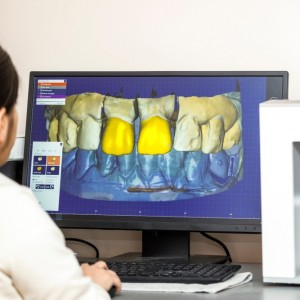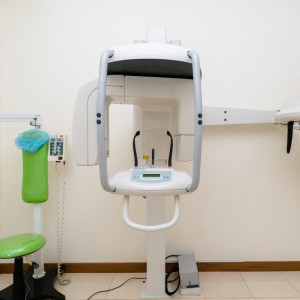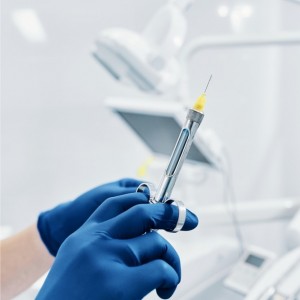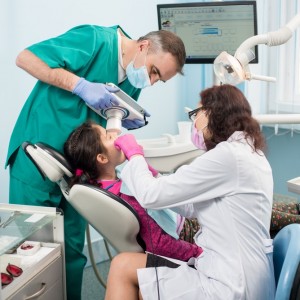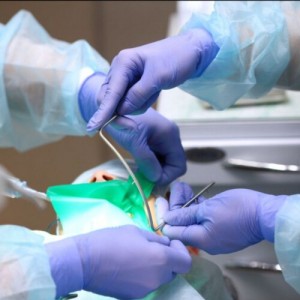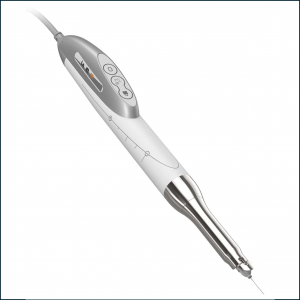
Dental Implants Could Feel More Like Real Teeth
Ech year, millions of people in the U.S. get dental implants as a long-term, natural-looking fix for missing teeth. But traditional implants don’t fully mimic real teeth.
Researchers from Tufts University School of Dental Medicine and Tufts University School of Medicine recently described a new approach to dental implants that that could better replicate how natural teeth feel and function. Their study, published in Scientific Reports, shows early success with both a “smart” implant and a new gentler surgical technique in rodents.
“Natural teeth connect to the jawbone through soft tissue rich in nerves, which help sense pressure and texture and guide how we chew and speak. Implants lack that sensory feedback,” says Jake Jinkun Chen, DI09, a professor of periodontology and director of the Division of Oral Biology at the School of Dental Medicine and the senior author on the study.
Traditional dental implants use a titanium post that fuses directly to the jawbone to support a ceramic crown, and the surgery often cuts or damages nearby nerves. To tie these inert pieces of metal into the body’s sensory system, the Tufts team developed an implant wrapped in an innovative biodegradable coating. This coating contains stem cells and a special protein that helps them multiply and turn into nerve tissue. As the coating dissolves during the healing process, it releases the stem cells and protein, fueling the growth of new nerve tissue around the implant.
The coating also contains tiny, rubbery particles that act like memory foam. Compressed so that the implant is smaller than the missing tooth when it’s first inserted, these nanofibers gently expand once in place until the implant snugly fits the socket. This allows for a new minimally invasive procedure that preserves existing nerve endings in the tissue around the implant.
“This new implant and minimally invasive technique should help reconnect nerves, allowing the implant to ‘talk’ to the brain much like a real tooth,” explains Chen. “This breakthrough also could transform other types of bone implants, like those used in hip replacements or fracture repair.”
Six weeks after surgery, the implants stayed firmly in place in rats, with no signs of inflammation or rejection. “Imaging revealed a distinct space between the implant and the bone, suggesting that the implant had been integrated through soft tissue rather than the traditional fusion with the bone,” says Chen. This may restore the nerves around it.
The research was conducted by Chen and School of Dental Medicine faculty Qisheng Tu and Zoe Zhu, as well as postdoctoral scholars Siddhartha Das (lead author) and Subhashis Ghosh at Tufts University School of Medicine.
These initial results are promising, but it will take more studies and time—for example, research in larger animal models to look at outcomes, including safety and efficacy—before trials can begin in human volunteers.
The researchers’ next step will be a preclinical study to see if brain activity confirms that the new nerves surrounding the prototype implant indeed relay sensory information.
Author: Genevieve Rajewski
Source: https://now.tufts.edu/
 Related articles
Related articles
Implantology 25 July 2025
Background: Cytokine–microbiology–virology monitoring after implant placement may help to develop profiles of variables that can help to explain interaction between the immune system and alveolar...
Prosthodontics 30 June 2025
Prosthodontic rehabilitation in the maxillary area using zirconia dental implants: a case report.
Purpose: Zirconia (ZrO2) is a ceramic material with adequate mechanical properties for manufacturing of medical devices. Zirconia stabilized with Y2O3 has the best properties for these applications.
Digital Dentistry 02 June 2025
A novel workflow for computer guided implant surgery matching digital dental casts and CBCT scan
Nowadays computer-guided “flap-less” surgery for implant placement using stereolithographic tem-plates is gaining popularity among clinicians and patients.
Restorative dentistry 30 May 2025
This clinical study was undertaken to evaluate the use of tissue-engineered bone, mesenchymal stem cells, platelet-rich plasma, and beta-tricalcium phosphate
 Read more
Read more
Oral Hygiene & Prevention 03 October 2025
Dental treatment planning and management for the mouth cancer patient
The need to deliver cancer treatment promptly often requires modification of ideal dental treatment plans.
Editorials 03 October 2025
To help stock the Filling Station, a food pantry open to anyone in our ASOD family who is experiencing food insecurity or needs help making ends meet, Adams School of Dentistry is holding a food...
Products 03 October 2025
From Scan to Smile: Aidite’s EZPRINT-P1 and Rapid 3 Deliver a Complete Digital Workflow
Digital dentistry thrives on precision, efficiency, and integration. Aidite has long been a leader in advancing these principles. With the introduction of the EZPRINT-P1 3D Printer, the company now...
Products 03 October 2025
Dentalhitec Americas recently announced the official U.S. launch of QuickSleeper5, following FDA clearance. Even prior to its American debut, demand from dentists for the QuickSleeper5.
News 03 October 2025
Excel Endodontics, a new specialty dental practice founded by endodontist Dr. Rachel Halpern, is proud to announce its official opening in Marlboro, New Jersey, along with the launch of its new...




